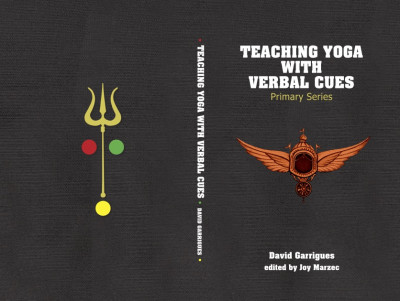
This book is a practical, one-of-a-kind resource for students and teachers of Ashtanga Yoga’s Primary Series. For every posture, you’ll find a clear photograph paired with a concise, potent list of verbal cues and physical actions.
Each entry gets straight to the heart of the pose—what to do with your legs, arms, spine, breath, and attention. You’ll learn how to ground, extend, spiral, and seal energy through simple, direct commands like:
“Stamp your feet evenly and lengthen upward from the base of your spine.”
“Catch your big toes and pull evenly as you lift your chest forward.”
“Breathe freely and let your awareness spread through the whole shape.”
The cues go far beyond alignment. You’ll find guidance on breathing, energetic direction, and inner awareness that transforms each asana into a practice of meditation and presence.
Whether you’re a teacher searching for precise language to guide your students, or a student wanting to unlock the essence of each pose, this book helps you practice safely, build strength and flexibility, and discover the transformative potential of the Primary Series.
Use it as a quick reference or a steady companion for long-term study. There’s no other resource like it—clear, practical, and full of usable insights that make the Primary Series come alive from the inside out.

— Strike down through your hands and firmly brace your arms.
— Imagine your arms and legs are dense and compact; ready for action like loaded springs.
— Strike Samasthitiḥ; align your head, torso, pelvis, and legs into an unbreakable horizontal stick.
— Pull up your navel and strengthen your center.
— Activate the “Big 4” muscle groups that surround your center: hamstrings, quadriceps, buttocks, and abdomen.
— Widen your back ribs and suck your front ribs up towards the spine; lift the top of your sternum and widen your collarbones.
— Hover your firm body just above the earth; focus your gaze forward with steely determination.

— Kick up strongly with your right leg while at the same time bowing forward.
— Lift your right leg up to meet your body rather than forcing your head down to meet your leg.
— Vigorously pull up with your right arm to help lift up your right leg.
— Stamp your left foot down and ground your left thigh.
— Stabilize your pelvis; hold firm to the axis, avoid shifting your pelvis back as you bow forward and lift your leg.
— Gaze forward with focus and determination.
— Engage yourself entirely in the challenging task; purify and grow strong.

— Reach up through your legs in a gesture of brilliant extension and pull down firmly on your feet with your hands.
— Lift up your chest, navel, and draw your torso closer to your strong, unmoving legs.
— Plant your forehead onto your shins; bend your elbows out to the sides and brace your arms.
— Shift forward towards your sitting bones and create a super stable position on the edge of imbalance.
— Gaze along your shins or up towards your feet.
— Allow this super charged version of Paścimattānāsana to teach you that dynamism transforms the dross of inertia into the gold of awakened consciousness.
Comments
No comments.